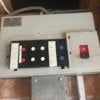As far as I understand, you can only have a 100 amp fuse fitted to your 'cutout' if it's externally mounted, not if it's indoors. This is handled by your DNO (e.g. Western Power Distribution in my case) who should be contacted by the charger installer to get approval to install the charger prior to any work taking place (due to the sustained demand, but some installers don't do this even though they should).
This is highly regional - UKPN are keen on 100A fuses; other DNOs won't go above 80A single phase under any circumstances. However, this is normally only relevant if you want to charge more than one EV at once, or if your house is unusually large or has a heavy use of electricity (electric heating etc.). It's almost certainly irrelevant to the OP's original question about charging from a 13A socket.
Note that charging from a 13A socket with the UMC (or any other manufacturer's equivalent) will only in fact draw 10A. This is because typical modern 13A sockets aren't good enough quality to deliver 13A continuously for hours on end. Even at 10A it is marginal and not recommended for daily use over long periods as you will often wear out the socket eventually - the plug gets warm in normal use even with everything as it should be, and any minor wear/dirt in the contacts makes it run even warmer, accelerating the wear until something melts. For occasional/short-term/emergency use it is fine however.
Rewireable fuses are not wonderful in comparison to more modern breakers or cartridge fuses, but they aren't a problem in themselves for this use. So long as the garage 13A socket is in reasonable physical condition and is protected by a fuse of at least 15A it should work OK. Also of concern in an old installation is whether wiring, junction boxes etc. are in good condition: from the photo, it looks merely old and otherwise quite tidy, but obviously that's only a small part of the installation that can be seen. There doesn't appear to be any RCD protection, so you are at risk if you do something crazy like running over the charge cable with a lawnmower or whatever else you keep in the garage, but that's a general risk in such an installation rather than specifically an EV charging issue.
As mentioned above, if you are worried about the quality of the wiring you are plugging in to, you can always use the controls in the car to charge slower than the 10A that the UMC allows for a 13A socket. Since heating is a square-law relationship with current, the good news is that a small reduction has quite a good improvement (reduce by charge speed by 10% and get a 19% reduction in heating); the bad news is that 10A is painfully slow in the first place.
So in summary, temporary charging from a 13A socket while you sort out something better will probably be fine.
When you do come to install a dedicated chargepoint, things may get more tricky; the installer's preference will probably be to tap a separate supply after the meter and leave your existing installation well alone (with a recommendation to upgrade it in due course). This may be fine if that can be done easily, but if this is a detached garage or otherwise far away from the meter, then running a new cable there may be tricky. Likewise, bonding cables will require to be updated to modern standards even if the EV charging is kept separate - that's normally only a few minutes' work, but can sometimes be more difficult. And as mentioned above, there may be issues of looped services or too-small supply fuse to be resolved. Usually these are solved fairly easily, but in the worst case you could be looking at some substantial work to sort out your existing installation before installing faster EV charging.



